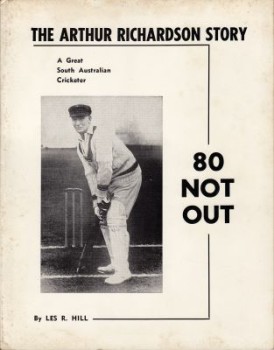80 Not Out
Martin Chandler |Published: 1966
Pages: 40
Author: Hill, Les R
Publisher: Private
Rating: 3 stars

To those who read cricket books today it will come as a surprise to learn of the paucity of cricketing biographies that had been published just a generation ago. Autobiographies, often disappointing ghosted efforts, were a little more common, but a properly researched life written by a professional writer was rare. There hadn’t been too many in England prior to 1966, and to the best of my knowledge only two biographies of Australian cricketers had appeared by that date, both by AG ‘Johnny’ Moyes. The titles were unimaginative, but self-explanatory, Bradman and Benaud, published in 1948 and 1962 respectively.
In the ensuing years many books have been written chronicling the lives of pre 1966 Australian Test cricketers. Some men, such as Bill Ponsford and Bill Woodfull, have been the subject of more than one, and in the case of Don Bradman a comprehensive collection of biographical works would represent a small library in itself.
In 1966 Les Hill privately published the third biography of an Aussie Test player, and two years later the fourth. In my early years as a collector, before I was in a position to invest in a copy of Padwick he was, by giving both books the same title, responsible for a good deal of confusion in my mind. It was a number of years and an opportunity to spend rather more than I could afford on the matching pair before my mind was finally put at rest, and that Hill had indeed chosen the same title for two separate books.
The next question that exercised my thoughts was why Hill chose to write about Bill Whitty and Arthur Richardson. Whitty was a left arm pace bowler who won 14 Test caps between 1909 and 1912. He took 65 wickets at 21, confirmation that had the Great War not had the effect of ending his career at 26 he might have set a good many records, but his has never been a stellar reputation. Neither was that of Richardson, an all-rounder who was already 36 when selected for the first of his nine Ashes Tests in the mid 1920s. What quickly becomes clear is that both men and Hill were living in South Australia in the 1960s, so it is easy to see why publishing the books was an attractive idea to Hill.
Having described both titles as books I probably should concede at this point that both are rather more in the nature of booklets. The Bill Whitty Story is only 40 pages long, and that of Richardson just a little longer at 44. Both men spoke at length to Hill and the booklets do represent the stories of their lives rather than just of their cricketing careers. That of Richardson is probably the more interesting. He was a man who, given the time in which he lived, certainly travelled a great deal. Inevitably not much of the men’s personalities come through, and there is no real input from their contemporaries, but both are interesting nonetheless.
The Tests in which Whitty appeared, and particularly those against South Africa in 1910/11 and the Triangular Tournament, are seldom now recalled. Arthur Richardson played a role in England’s famous win at the Oval in 1926, so his name crops up a little more often, but both of these booklets deal in the main with events well away from the mainstream and that, in the 21st Century, is a factor that weighs in their favour.
As far as appearances are concerned the booklets are rather different. The Whitty volume is smaller, but a more sophisticated production with the distinctive use of three columns to each page reinforcing the message that the booklet is the collection of newspaper articles that it is. It has a number of illustrations, and whilst there is no statistical section as such the important numbers are there. Padwick does not mention any limitation in the number of copies that were printed but it seems to me to be no more common, nor rare, than the Richardson of which Padwick states there are 150 copies.
The Richardson itself is, as indicated, slightly larger and has a few more pages but in many ways it is entirely dissimilar to the Whitty. Old fashioned in the extreme the production is what I believe is called cyclostyled, thus in effect it has been typed and then copied. The leaves are all single-sided so it is rather more substantial than the Whitty despite being only four pages longer. Sadly that method of production does not permit any illustrations, although there is an image of a remarkably pensive looking Richardson on the front cover. Neither booklet appears on the market very often but for the diligent collector there is usually the odd copy to be found, and indeed Roger Page’s latest catalogue contains a Richardson at AUS$200, which might still be available.






Les Hill was a bookseller at Mount Gambier who accelerated my growing interest in books on cricket when I visited the town where my postmaster father was a friend of Hill. His shelves held an unusual number of books on the game, and I bought several at discounted prices. Les had a magnificent collection of early players’ autographs, which I understand went to a good home in due course.
Comment by Murray Hedgcock | 11:19pm BST 17 April 2016